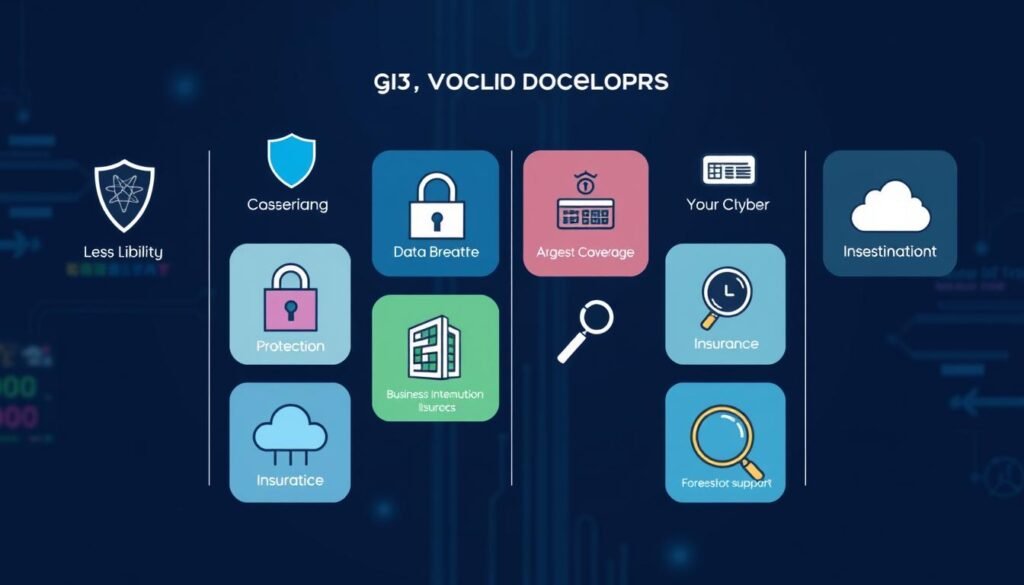As an MSP, you protect your clients’ data and IT systems. But did you know data breach costs jumped 12.7% in 2022? Globally, the average cost was $4.35 million, and in the U.S, it was $9.44 million1. With cyber insurance policies usually covering up to $5 million, your business needs strong protection against cyber threats1.
MSP cyber insurance is vital for your IT business. It helps you recover from cyber incidents. As an MSP, you’re key in IT and compliance. Having the right insurance, like tech E&O and cyber liability, is a must1.
Small businesses, like many MSPs, face higher cyberattack risks. Cyber insurance is essential for your business1. With the right cyber insurance, you protect your business, keep client trust, and ensure success in the cybersecurity world.
Key Takeaways
- Cyber attacks are on the rise, with the average cost of a data breach reaching $4.35 million globally and $9.44 million in the U.S.
- MSPs are prime targets for cybercriminals, making cyber insurance a critical investment for IT businesses.
- MSP cyber insurance can help your business recover from data breaches, cyber extortion, regulatory fines, and other cyber incidents.
- Implementing security best practices and aligning your insurance coverage can help you negotiate favorable policy terms.
- Partnering with a competent cyber insurance broker can provide guidance on policy inclusions, exclusions, and suitable carriers.
The Rising Threat of Cyberattacks on MSPs
Cybercrime is making millions for bad guys. Between 2021 and 2023, data breaches jumped by 72%, setting new records2. The cost of a big data breach in 2024 is expected to hit $4.88 million, another record2. This makes MSPs a prime target for hackers, who want to get to customer data and systems.
Staggering Statistics on Data Breaches
Data breaches are a big deal. Small and medium-sized businesses (SMBs) were hit in 43% of breaches, losing about $7 billion2. Cybercrime is expected to cost $10.5 trillion by 20252. Sadly, 60% of SMBs that get hacked go out of business within six months2.
Why Cybercriminals Target MSPs
MSPs are seen as easy targets by hackers. They have access to lots of client data and systems. Almost all MSPs have been hacked in the last 18 months, and most face more attacks now than during the pandemic2. This shows MSPs need strong security and might want to think about cyber insurance.
The digital world is getting more complex, with more IoT devices and remote work3. Hackers are using new tricks to get into MSP networks and find weaknesses3. MSPs need to stay ahead by having good user policies, training, secure remote access, and strong endpoint protection3.
“Cybercrime is as lucrative as ever, generating millions in illicit revenues for threat actors.”
MSPs must focus on their cybersecurity and think about cyber insurance to protect themselves and their clients. Knowing the risks and why hackers target MSPs helps MSP owners make smart choices to keep their businesses safe and successful.
What is MSP Cyber Insurance?
Managed service providers (MSPs) face a growing threat from cyberattacks. To protect their businesses and clients, MSPs need msp cyber insurance coverage. This insurance can greatly reduce the financial and operational damage from a data breach or cyber incident4.
Understanding First-Party and Third-Party Coverage
Cyber liability insurance for MSPs includes two main parts: first-party cyber insurance and third-party cyber insurance. First-party coverage helps with costs from a data breach, like investigation and recovery5. Third-party coverage protects against claims from clients or others, keeping the MSP safe from legal and financial issues5.
Cyber insurance is a vital safety net for MSPs. It offers financial help and expertise to deal with cyberattacks4. Knowing the difference between first-party and third-party coverage helps MSPs choose the right insurance. This ensures they are well-protected in the changing cyber world5.
| Coverage Type | Description |
|---|---|
| First-Party Cyber Insurance | Covers expenses related to the MSP’s own data breach or cyber incident, such as investigation, recovery, and ransom payments. |
| Third-Party Cyber Insurance | Protects the MSP against liability claims made by their clients or other affected parties, shielding them from legal and financial liabilities. |
Understanding first-party cyber insurance and third-party cyber insurance is key. MSPs can then choose the best insurance for all cyber threats they might face5.

Types of msp cyber insurance Policies
Protecting your managed service provider (MSP) business from cyber threats is key. MSP cyber insurance policies are made to handle the unique risks MSPs face. They cover various damages and liabilities6.
Many MSP cyber insurance policies offer both first-party and third-party coverage. First-party coverage helps with costs from a data breach, like notifying clients and forensic investigations. Third-party coverage protects against claims from clients or others due to a cyber incident6.
Specialized MSP cyber insurance policies may also have higher indemnity limits. This is vital for MSPs, as they must protect their clients in case of a cyberattack6.
Choosing the right MSP cyber insurance policy is important. It should match your business needs. This ensures your MSP is well-protected against cyber threats4.

Getting the right MSP cyber insurance is critical for your business and clients’ data. By understanding your options and tailoring your policy, you can reduce financial and reputational risks from cyber incidents4.
Coverage Areas of Cyber Insurance
Cyber insurance policies offer broad protection against cyberattacks and data breaches. They cover several key areas to protect your MSP business7.
Cyber Liability Coverage
This coverage handles the costs of a data breach that reveals sensitive info. It shields your MSP from claims and lawsuits from third parties7.
Cyber Risk Coverage
This coverage pays for your MSP’s losses from a cyber incident. It covers the costs of IT forensics teams and restoring systems. It helps reduce the financial hit of a cyberattack7.
Business Interruption Coverage
This coverage helps MSPs that face downtime due to a cyberattack. It aids in recovering lost revenue and getting operations back on track7.
Errors and Omissions Coverage
This coverage guards against damages from unmet contractual obligations due to a cyber incident. It prevents costly legal battles and financial losses7.
Knowing the different cyber insurance coverage areas helps MSPs protect their business and clients. It safeguards their reputation against cyberattacks7.

| Coverage Type | Description | Key Benefits |
|---|---|---|
| Cyber Liability | Covers costs related to data breaches that expose sensitive information | Protects against third-party claims and lawsuits |
| Cyber Risk | Reimburses first-party losses from cyber incidents, such as forensics and system restoration | Mitigates the direct financial impact of a cyberattack |
| Business Interruption | Provides financial assistance for lost revenue and recovery costs during downtime | Helps MSPs get back up and running after a cyber incident |
| Errors and Omissions | Protects against damages related to unfulfilled contractual obligations | Avoids costly legal battles and financial liabilities |
“Cyber losses cost the global economy upwards of $1.5 trillion annually7. Proper cyber insurance coverage is key for MSPs to fight cyber threats and protect their business.”
Selecting the Right Cyber Insurance Policy
As an MSP, picking the right cyber insurance is key to protecting your business and clients. Your security risk profile, shaped by your clients, tech, and security team, is vital in choosing the right policy8. Not all policies cover the same things, and extra coverage can cost more.
Assessing Your Security Risk Profile
Cyber insurance isn’t one-size-fits-all. Every MSP has unique risks. The best policy matches your specific profile8. Show that you follow industry standards to get better insurance.
Understanding Policy Terms and Conditions
It’s important to read the fine print of a cyber insurance policy. Look at the policy limits to avoid big liability in attacks8. Also, check what’s not covered, deductibles, and the insurer’s reputation for the best coverage.
| Factors to Consider | Importance |
|---|---|
| Coverage Limits | Crucial to avoid liability for large-scale attacks |
| Policy Exclusions | Understand what is and isn’t covered |
| Deductibles | Determine your out-of-pocket costs |
| Insurer Reputation | Ensure prompt and reliable claims processing |
By evaluating your security risk and policy details, you can find the right cyber insurance for your MSP9.
“Cyber insurance is no longer a luxury – it’s a necessity in the digital age. Protecting your MSP and your clients should be a top priority.” – Cybersecurity Expert
Remember, a solid risk management plan, cyber insurance, and strong security practices are key. They help prevent breaches and make the most of cyber insurance9.
Cyber Insurance Costs and Premiums
Small businesses pay between $1,000 and $7,500 a year for cyber insurance costs and cyber insurance premiums10. Large companies often pay more. Using secure technologies and following compliant workflows can lower these costs for Managed Service Providers (MSPs).
Cavelo Inc. and DataStream Insurance help MSPs manage cyber risk. This can cut cyber insurance premiums by 10 percent or more10.
Factors Affecting Premiums
The factors impacting cyber insurance rates include coverage areas, policy limits, and your organization’s security risk profile10. The global cyber insurance premiums are expected to hit over $20 billion soon, up from nearly $15 billion in 202311. Rates fell by 6% worldwide in the first quarter, with a 6% drop in the U.S. This marks the fourth straight quarter of rate declines11.
Small- to medium-sized enterprises are buying cyber insurance more due to ransomware concerns and broker advice11. The market has grown more competitive, leading to lower costs and higher coverage limits11. Insurance companies now require things like multifactor authentication and employee training11.

“The average cost of cyber liability insurance for a U.S. business was $132 per month or $1,589 per year in 2021.”10
Cyber insurance premiums might go up if a company had a cyber attack in the past year10. Many things affect cyber insurance costs, like technology used, organization size, revenue, claims history, and industry10.
Negotiating Favorable Insurance Terms
To get good cyber insurance, you need to know your security risks and take steps to protect yourself. Insurers want to work with the safest companies. So, showing you’re serious about security can help you get better insurance deals.
Implementing Security Best Practices
First, make sure your company follows top security practices. This means using multi-factor authentication, keeping backups for 48 hours, and updating software automatically12. These steps show you’re serious about keeping your data safe and can lead to better insurance terms.
Enhancing Incident Response Capabilities
Insurers also look at how you handle cyber attacks. Be ready to explain how you find, stop, and fix cyber problems12. A solid plan for dealing with cyber attacks shows you’re ready to handle threats.
Aligning Security Investments with Insurance Policies
To get the best insurance deals, match your security spending with your insurance12. Focus on security measures that match the risks your insurance covers13. This shows you’re serious about managing risks and can lead to better insurance terms.
“Cyber insurance has become more prevalent, with more companies including cyber risk coverage in their risk management strategies.”13
To get good cyber insurance terms, show you’re a responsible and secure company. Use top security practices, improve your response to cyber attacks, and match your security spending with your insurance. This makes you a safer bet for insurers, leading to better deals.
The Role of MDM and Endpoint Protection
As Managed Service Providers (MSPs), keeping your clients’ devices and data safe is key. With more people using mobile devices for work14, strong mobile device management (MDM) and endpoint protection are more important than ever.
Endpoint detection and response (EDR) technology is a big part of keeping things safe14. EDR software protects data on many devices, like phones, laptops, and IoT systems14. It has features like finding threats fast, stopping malware, and wiping devices remotely, giving your clients’ devices top-notch security.
JumpCloud: Securing Client Devices for Better Insurance Terms
JumpCloud is a top name in cybersecurity, with a flexible system for MDM and endpoint protection. It lets you manage many devices at once and set up or remove them easily for all your clients1415. Using JumpCloud can help you find better, cheaper cyber insurance by meeting strict security standards.
JumpCloud’s MDM and EDR solutions give your clients’ devices a strong security layer1516. It has tools like geofencing, remote access, and logging, helping you keep devices safe and secure. This makes sure your clients’ businesses can run smoothly without worry.
Working with JumpCloud shows insurance providers you’re serious about keeping devices safe16. This can lead to better insurance deals and policies, protecting your business and clients from cyber threats.
“Endpoint management solutions provide visibility and control over the IT environment, aiding in quicker identification and resolution of IT incidents.”16
Conclusion
The threat of cyber attacks is growing fast. MSP cyber insurance is now key for managed service providers (MSPs) to protect their business and clients. By knowing the different cyber insurance policies, what they cover, and how much they cost, MSPs can pick the best one to lower their cyber risk.
Using strong security practices, improving how they respond to incidents, and matching security spending with insurance can help MSPs get better insurance deals. This also lowers their overall cyber risk. Plus, having good cybersecurity and cyber insurance together helps MSPs deal with the costs of a cyber attack, like legal fees and lost income.
In short, being proactive about cyber risk management, including getting MSP cyber insurance, is vital for MSPs. It helps protect their business, keeps client trust, and ensures they can succeed against new cyber threats.
FAQ
What is MSP cyber insurance and why is it important for my business?
What are the current cybersecurity threats facing MSPs?
How does cyber liability insurance protect my MSP business?
What are the different types of MSP cyber insurance policies?
What types of coverage do cyber insurance policies typically provide?
How do I select the right cyber insurance policy for my MSP?
How much does cyber insurance typically cost for MSPs?
FAQ
What is MSP cyber insurance and why is it important for my business?
MSP cyber insurance helps your company recover from cyber threats. It’s a must for businesses that handle personal info. MSPs need insurance for IT and compliance, and small businesses are often targeted by cyberattacks.
What are the current cybersecurity threats facing MSPs?
Cybercrime is booming, with threat actors making millions. Data breaches have increased by 72% from 2021 to 2023. The average cost of a breach in 2024 is .88 million.
Cybercriminals target MSPs for customer data. Almost all MSPs have faced a cyberattack in 18 months. Nine out of 10 report more attacks now than during the pandemic.
How does cyber liability insurance protect my MSP business?
Cyber liability insurance is a backup plan for MSPs. It helps soften the blow of a cyberattack. It covers cyberattacks and data breaches, protecting MSPs from unlimited damages.
It covers investigation and recovery costs, ransom payments, and more. Policies have first-party and third-party coverage. First-party helps with expenses from a data breach. Third-party protects against claims from others.
What are the different types of MSP cyber insurance policies?
There are many MSP cyber insurance policies. Each covers different damages to varying degrees. Policies often cover first-party and third-party damages separately.
First-party coverage helps with expenses from a data breach. Third-party coverage protects against claims from others. MSPs face unique legal and financial risks from cyberattacks.
What types of coverage do cyber insurance policies typically provide?
Cyber insurance policies cover various types of incidents. Cyber liability coverage protects against third-party claims. Cyber risk coverage reimburses for first-party losses from a cyber incident.
Business interruption coverage pays for downtime due to a cyberattack. Errors and omissions coverage protects against damages from unfulfilled obligations due to a cyber incident.
How do I select the right cyber insurance policy for my MSP?
The right cyber insurance policy depends on your MSP’s security risk profile. Not all policies cover the same events, and extra coverage costs more. Your risk profile is based on your clients, tech stack, and security expertise.
When choosing a provider, consider policy limits and the need to show compliance with security frameworks. Higher-quality providers often require this.
How much does cyber insurance typically cost for MSPs?
Cyber insurance costs between
FAQ
What is MSP cyber insurance and why is it important for my business?
MSP cyber insurance helps your company recover from cyber threats. It’s a must for businesses that handle personal info. MSPs need insurance for IT and compliance, and small businesses are often targeted by cyberattacks.
What are the current cybersecurity threats facing MSPs?
Cybercrime is booming, with threat actors making millions. Data breaches have increased by 72% from 2021 to 2023. The average cost of a breach in 2024 is $4.88 million.
Cybercriminals target MSPs for customer data. Almost all MSPs have faced a cyberattack in 18 months. Nine out of 10 report more attacks now than during the pandemic.
How does cyber liability insurance protect my MSP business?
Cyber liability insurance is a backup plan for MSPs. It helps soften the blow of a cyberattack. It covers cyberattacks and data breaches, protecting MSPs from unlimited damages.
It covers investigation and recovery costs, ransom payments, and more. Policies have first-party and third-party coverage. First-party helps with expenses from a data breach. Third-party protects against claims from others.
What are the different types of MSP cyber insurance policies?
There are many MSP cyber insurance policies. Each covers different damages to varying degrees. Policies often cover first-party and third-party damages separately.
First-party coverage helps with expenses from a data breach. Third-party coverage protects against claims from others. MSPs face unique legal and financial risks from cyberattacks.
What types of coverage do cyber insurance policies typically provide?
Cyber insurance policies cover various types of incidents. Cyber liability coverage protects against third-party claims. Cyber risk coverage reimburses for first-party losses from a cyber incident.
Business interruption coverage pays for downtime due to a cyberattack. Errors and omissions coverage protects against damages from unfulfilled obligations due to a cyber incident.
How do I select the right cyber insurance policy for my MSP?
The right cyber insurance policy depends on your MSP’s security risk profile. Not all policies cover the same events, and extra coverage costs more. Your risk profile is based on your clients, tech stack, and security expertise.
When choosing a provider, consider policy limits and the need to show compliance with security frameworks. Higher-quality providers often require this.
How much does cyber insurance typically cost for MSPs?
Cyber insurance costs between $1,000 and $7,500 annually for small businesses. Large organizations pay more. Secure technologies and compliant workflows can lower premiums.
Costs depend on coverage areas, policy limits, your risk profile, and the provider’s compliance requirements.
How can I negotiate more favorable terms with my cyber insurance provider?
Show your MSP’s commitment to security to get better terms. Implementing security best practices can make your organization stand out. Insurers value incident response capabilities.
Aligning your security investments with your insurance policy can also help. This can positively impact the terms you receive.
How can JumpCloud help my MSP meet cyber insurance requirements?
JumpCloud offers MDM and endpoint protection for MSPs. It secures multiple device fleets and automates provisioning and deprovisioning. Deploying JumpCloud can help meet insurance requirements, leading to better terms from insurers.
,000 and ,500 annually for small businesses. Large organizations pay more. Secure technologies and compliant workflows can lower premiums.
Costs depend on coverage areas, policy limits, your risk profile, and the provider’s compliance requirements.
How can I negotiate more favorable terms with my cyber insurance provider?
Show your MSP’s commitment to security to get better terms. Implementing security best practices can make your organization stand out. Insurers value incident response capabilities.
Aligning your security investments with your insurance policy can also help. This can positively impact the terms you receive.
How can JumpCloud help my MSP meet cyber insurance requirements?
JumpCloud offers MDM and endpoint protection for MSPs. It secures multiple device fleets and automates provisioning and deprovisioning. Deploying JumpCloud can help meet insurance requirements, leading to better terms from insurers.
How can I negotiate more favorable terms with my cyber insurance provider?
How can JumpCloud help my MSP meet cyber insurance requirements?
Source Links
- What Every MSP Should Know About Cyber Insurance – CyberFOX – https://www.cyberfox.com/blog-what-every-msp-should-know-about-cyber-insurance/
- Council Post: Managed Service Providers (MSPs) Have Been Left Out Of The Cyber Insurance Game – https://www.forbes.com/councils/forbestechcouncil/2024/03/29/managed-service-providers-msps-have-been-left-out-of-the-cyber-insurance-game/
- The Next Wave of Cybersecurity: Protecting Your MSP and Your Clients from Emerging Threats – https://seedpodcyber.com/the-next-wave-of-cybersecurity-protecting-your-msp-and-your-clients-from-emerging-threats/
- Managed Service Providers (MSPs) Insurance Guide – https://foundershield.com/blog/msp-insurance/
- The Power of Cyber Insurance: What Every MSP Should Know | Huntress – https://www.huntress.com/blog/the-power-of-cyber-insurance-what-every-msp-should-know
- MSP Insurance Policies: Everything IT Businesses Need to Know – https://www.channelinsider.com/managed-services/insurance-policies-for-msp-and-it/
- Coalition | Cyber Insurance Coverage Checklist – https://www.coalitioninc.com/topics/cyber-liability-insurance-checklist
- Comprehensive Guide to Cyber Insurance for MSPs – https://jumpcloud.com/blog/cyberinsurance-guide-for-msps
- Benefits of cyber insurance for MSPs | Sherweb – https://www.sherweb.com/blog/security/benefits-of-cyber-insurance-for-msps/
- How Much Does Cyber Insurance Cost? – https://www.coalitioninc.com/topics/cyber-liability-insurance-cost
- Cyber insurance costs are stabilizing as global market grows – https://www.cybersecuritydive.com/news/cyber-insurance-costs-market-grows/716040/
- How Managed Service Providers (MSPs) can provide cyber insurance to protect businesses from attacks in a few ways – https://www.linkedin.com/pulse/how-managed-service-providers-msps-can-provide-cyber-insurance-singh
- What is Cyber Insurance and Why Do You Need it? – https://vipre.com/glossary-terms/what-is-cyber-insurance-and-why-do-you-need-it/?srsltid=AfmBOooQ7p4Xa5yZJeAiR43MXy-SrRyuIXDAQkpqiW37BkRUOdFjazjs
- Mobile Endpoint Security and Management | EDR and MDM – https://www.xcitium.com/blog/endpoint-protection/mobile-endpoint-security/
- Mobile Device Management for MSPs – https://www.msp360.com/resources/blog/mobile-device-management-for-msps/
- What Is Endpoint Management? MDM, EMM, and UEM – https://www.cynet.com/endpoint-security/what-is-endpoint-management-mdm-emm-and-uem/
